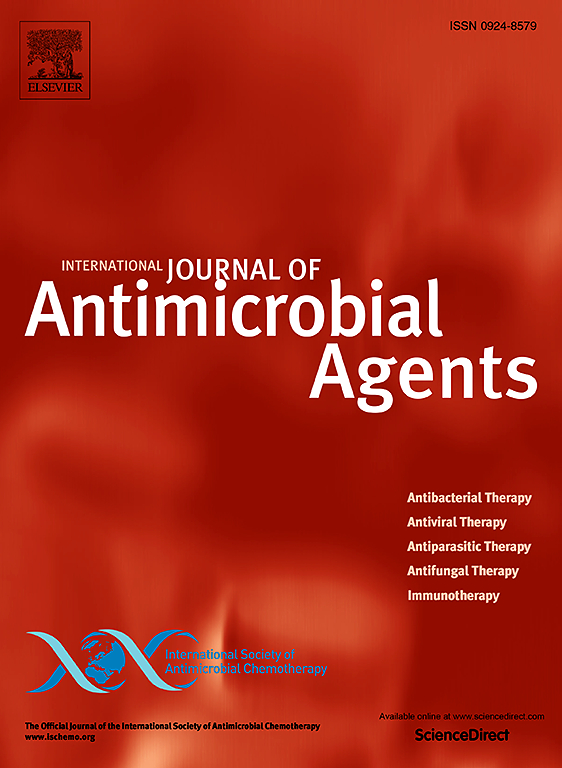VRP-034的毒性动力学分析:评估其减轻多粘菌素b相关肾毒性的潜力。
IF 4.9
2区 医学
Q1 INFECTIOUS DISEASES
International Journal of Antimicrobial Agents
Pub Date : 2025-02-01
DOI:10.1016/j.ijantimicag.2024.107393
引用次数: 0
摘要
该研究评估了VRP-034(新型多粘菌素B [PMB])的肾毒性和毒性动力学特征,并在7天的重复给药方案中与上市的PMB进行了比较。研究有三个目标:评估两组患者PMB的药代动力学,同时评估VRP-034对减轻PMB相关肾损伤的影响;分析肾损伤的可逆性;并使用组织病理学评分验证新型肾损伤生物标志物与传统标志物的对比。将68只Sprague-Dawley大鼠分为3组:市售PMB组和VRP-034组各30只,对照组8只。动物每8小时皮下注射6mg /kg药物(HED ~ 3mg /kg/天)。选取动物在第1、2、4、7天(第3、6、12、21次给药后)进行毒代动力学评价,其余动物在另外7天的无药期进行观察。给药后12小时采集样本,然后进行尸检和组织病理学检查。测定血浆PMB浓度;评估肾损伤生物标志物、氧化应激和抗炎标志物。进行受试者操作者特征曲线分析,以验证肾损伤生物标志物与组织病理学分级。结果显示两组血浆PMB浓度和药代动力学参数相似。然而,与上市的PMB组相比,VRP-034组表现出明显较低的肾毒性,肾损伤生物标志物水平降低,氧化应激和炎症水平降低。组织病理学检查证实VRP-034组肾损害减轻。新型肾损伤生物标志物表现出优于传统标志物的敏感性、特异性和早期检测能力。总之,与已上市的PMB相比,VRP-034表现出更低的肾毒性,表明其作为更安全的替代品的潜力。本文章由计算机程序翻译,如有差异,请以英文原文为准。
Toxicokinetic profiling of VRP-034: Evaluating its potential in mitigating polymyxin-B-associated nephrotoxicity
This study assessed the nephrotoxicity and toxicokinetic profile of VRP-034 [a novel formulation of polymyxin B (PMB)] compared with marketed PMB over a 7-day repeat-dose regimen. Three objectives were pursued: evaluating PMB pharmacokinetics in both groups, alongside assessing the impact of VRP-034 on mitigating PMB-associated kidney injury; analysing the reversibility of kidney injury; and validating novel kidney injury biomarkers against traditional markers using histopathological scoring.
Sixty-eight Sprague-Dawley rats were divided into three groups: 30 in each of the marketed PMB and VRP-034 groups, and eight in the control group. Rats received drugs at 6 mg/kg subcutaneously every 8 h (human equivalent dose ∼3 mg/kg/day). Toxicokinetic evaluations were conducted on selected animals on days 1, 2, 4, and 7 (after 3rd, 6th, 12th and 21st dose), while the remaining animals were observed for an additional 7 days without treatment. Samples were collected up to 12 h post-administration, followed by necropsy and histopathological examination. Plasma PMB concentrations were quantified; and kidney injury biomarkers, oxidative stress and anti-inflammatory markers were evaluated. Receiver operating characteristic curve analysis was performed to validate kidney injury biomarkers against histopathological grading.
Similar plasma PMB concentrations and pharmacokinetic parameters were found in the two treatment groups. However, the VRP-034 group exhibited significantly lower nephrotoxicity, with reduced levels of kidney injury biomarkers, and diminished oxidative stress and inflammation levels compared with the marketed PMB group. Histopathological examination confirmed reduced renal damage in the VRP-034 group. Novel kidney injury biomarkers demonstrated superior sensitivity, specificity and early detection capability over traditional markers.
In conclusion, VRP-034 demonstrated reduced nephrotoxicity compared with marketed PMB, suggesting its potential as a safer alternative.
求助全文
通过发布文献求助,成功后即可免费获取论文全文。
去求助
来源期刊
CiteScore
21.60
自引率
0.90%
发文量
176
审稿时长
36 days
期刊介绍:
The International Journal of Antimicrobial Agents is a peer-reviewed publication offering comprehensive and current reference information on the physical, pharmacological, in vitro, and clinical properties of individual antimicrobial agents, covering antiviral, antiparasitic, antibacterial, and antifungal agents. The journal not only communicates new trends and developments through authoritative review articles but also addresses the critical issue of antimicrobial resistance, both in hospital and community settings. Published content includes solicited reviews by leading experts and high-quality original research papers in the specified fields.

 求助内容:
求助内容: 应助结果提醒方式:
应助结果提醒方式:


